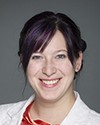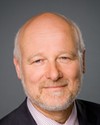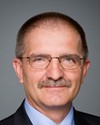Thank you for this opportunity.
As mentioned, my name is Janice Wright. I'm a medical doctor and the CMO of InspireHealth. We are a non-profit charity in Vancouver, British Columbia.
I'd like to talk today about bringing health into health care by using the example of our cancer care model. For us the most innovative thing that we could introduce into our health care system is the support of health.
I'll give a little bit of background on InspireHealth. We're a not-for profit. We were founded 18 years ago by two medical doctors. We are still to this day physician led. We provide a team approach to cancer care. We are grateful to be partially funded by the B.C. Ministry of Health. We work with local and national cancer foundations and would welcome a stronger opportunity to work with the national cancer strategy. I'd like to move right into talking about our current situation in health care.
We view this health care system as being actually more a disease treatment system, or as some people call it, a sick care system, rather than a health care system. Part of the reason for this is that as physicians, we're trained almost exclusively to diagnose and treat disease. Very little time in medical school is dedicated to learning to support our own or our patients' health.
As we all know, money alone will not save the health care system. The focus of our current system is on how to diagnose and treat disease, and few resources are given to prevention. In fact, as physicians and other allied health care providers, we are left to mop up when patients, who perhaps haven't learned how to take care of themselves properly or optimally, develop significant and chronic diseases.
Have we asked ourselves as physicians, as patients, as decision-makers, how we can work to turn off the tap, how we can work more towards prevention?
Our health care system currently does not effectively teach or model health. Medical students and residents, as I mentioned, don't learn how to support their own health let alone their patients' health. We learn how to diagnose and treat disease. Many doctors, as we know, are stressed and burned out and not in the position to model health for their patients.
Turning to our slides, in the disease treatment model, using cancer as an example from our practice, you'll see the tumour with standard therapy, such as surgery, chemotherapy, and radiation targeting the cancer, targeting the tumour, and the physician is the expert and advises the patient on what to do for their health.
In a fuller health care model, those standard therapies are still important. The surgery and chemo and radiation are still targeting the T—for tumour—in this next slide. However, you'll see all of these other ways that the patient...but also allied health care providers including physicians can support the patient to actually feel well, and perhaps to even have a better outcome than they would have with just standard cancer therapies alone.
I'd like to also point out—on the right-hand side of this slide—that the patient is in the driver's seat here. In fact, sometimes at InspireHealth we call them a participant. The patient is having conversations with their physician, their allied health care providers, and we are all having conversations with one another.
It is absolutely essential that patients become empowered, that they take responsibility, that they become engaged in their own health. Physician engagement in health care is equally important. Again, it's essential that physicians learn how to take care of themselves so that they can model this and support patients along the way, working as guides, as educators, as supporters, in addition to being diagnosticians and people who treat. This leads to a very powerful relationship, the physician-patient partnership, where they work together on shared decision-making and work to support the patient's good health.
You might be surprised to hear that actually many of our cancer patients who are working with a life-threatening illness tell us they've never felt better in their lives.
I'd like to also touch on two health care assumptions that I believe are quite prevalent.
One is that health is simply the absence of a diagnosable disease. Patients are sent the message from our current system that they need to be diagnosably sick before they go in to talk to a health care provider about their health.
There is a commercial on TV right now—I'm sure there have been many in the past, and there will be more in the future—that is quite compelling. I won't mention the name of the company. However, a gentleman who appears to be 20 to 25 pounds overweight runs into his home gleefully to eat foods that are highly processed, high-fat foods spread all across the dining-room table. The important part of this commercial is that he has a pill to take for his heartburn. Now, perhaps he doesn't have a diagnosable illness. He may consider himself to be healthy, and just needs to run to the drugstore for his next dose of a pill that might suppress his reflux. But this gentlemen being 24 pounds overweight, as we all know, is at higher risk for developing diabetes, cardiovascular disease, high blood pressure, and other illnesses.
Health is much, much more than the absence of a diagnosable disease.
The other assumption I'd like to touch on today is that people already know how to take care of their own health. I don't actually think that's true in many cases. In fact, as I mentioned, as physicians we don't necessarily know how to optimally take care of our health, or our patients' health either.
I'd like to show you this chart on the slide that reads “Deaths from Heart Disease”. I'd like to give you the example of cardiovascular disease.
Prior to the 1970s and healthy heart programs becoming de rigueur, patients were coming through the emergency room with an acute cardiac event and being told by their physicians that there was nothing that could be done for them. In fact, they were advised not to exercise because it would put them at higher risk for damaging their heart muscle and would lead to another cardiac event or death. Patients were labelled “cardiac cripples”. They were told that diet does not make a difference.
Thanks to some research, mostly that came out of the U.S., there was a change such that now healthy heart programs are recommended to every patient that has a cardiac event. Patients are up and walking and exercising the day after they have either cardiac surgery or an angioplasty. It's very, very powerful medicine. It shows that until that time, we as physicians didn't even know what was best for our patients' health. It's important that we recognize that we don't all necessarily know how to take care of our health and there is much to learn beyond just diagnosing disease.
I'd like to tell you a bit about InspireHealth's model of care. Again, we work exclusively at this time, mandated by the B.C. Ministry of Health, with cancer patients, adults living with cancer and their families. I'll highlight that in a moment.
We believe that we have an innovative program. We are research based. We support the health of cancer patients, but we also support the health of their families. The families come in and learn how to eat healthily through our cooking classes and other programs. They learn how to reduce stress in their lives, not just acutely but long term. They work towards restorative sleep and healthy nutrition. They learn to exercise. They take the programs home with them, or they participate in our exercise or other movement classes. They are provided with emotional and spiritual support.
One of the most important things is that with these group programs, they end up supporting one another. It's in a supportive environment. We provide patient-centred care, a team approach with allied health professionals including nutritionists, counsellors, and exercise therapists. We provide not only in-person programs but also virtual programs that we've now taken across Canada.
I mentioned that we were research based. I want to provide two examples. I won't go into the details, although I'm happy to provide references if you are interested. One shows that physical activity can actually help to prevent cancer in these particular cancers, and the other shows that physical activity can actually help breast cancer patients survive.
Coming to my conclusions, we believe at InspireHealth that the greatest innovation is to bring health into health care. One of the solutions, and a very important one in our eyes, is to actually educate physicians through formal modules on how to take care of their own health and how to support others in their health, so that physicians become educators. They become guides and supports in addition to diagnosticians. They are providing patient-centred care where the patient is in the driver's seat and this powerful relationship between doctor and patient, or other health care provider and patient, is strongly supporting health.
I cannot say enough about group programs. These have been instigated in certain cases across Canada, and I cannot say enough about them. I actually wonder whether we support our patients more greatly or they support one another more greatly. They've been there, and they can support one another in the lifestyle changes they're making that help them feel well and are potentially changing the course of their disease. A team approach is very important, where physicians learn to work not just in a multidisciplinary setting behind closed doors or siloed, but actually alongside one another toward the greatest health for all.
Our model of care is applicable Canada-wide. We've taken it in a virtual way across Canada to date. It is something that we would be happy to be consultants on, to help support the entire spectrum of health across Canada, not only for chronic disease, but for the whole spectrum, including prevention.
Our virtual programs, as I mentioned, have been supporting patients in underserviced areas already, and for patients across the country who don't have access to our services in person. We forge strategic partnerships across Canada with cancer agencies and foundations, and as mentioned, we would welcome the opportunity to work more strongly with the national cancer strategy.
We are very honoured that we are being studied by an international research institute at the moment. It's a four-year study. They have received a sizable research grant to study our model of care. They are doing an observational study, looking at survival outcomes and quality of life. We would also look forward to an economic analysis after that.
I welcome any questions. Thank you.






